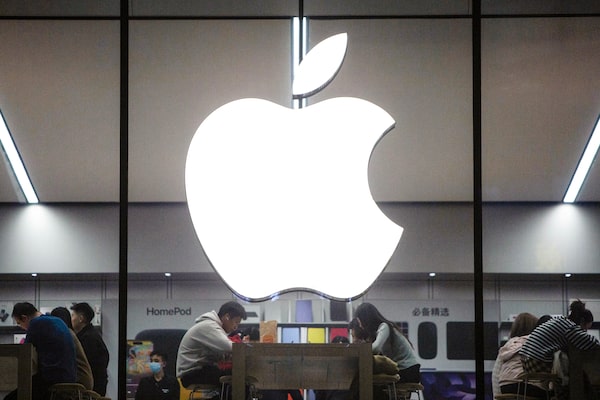A U.S. Federal Reserve meeting and Apple Inc. and Amazon.com Inc. reporting results will keep investors’ focus in the days ahead on the global rates outlook and on tech earnings, while growth and inflation data from Europe and China are also coming out.
Here’s what to expect in the coming days:
WILL THEY, WON’T THEY?
A trader works, as a screen broadcasts a news conference by U.S. Federal Reserve Chair Jerome Powell following the Fed rate announcement, on the floor of the New York Stock Exchange in New York City on March 20.Brendan McDermid/Reuters
Hints of whether the Fed still expects interest-rate cuts at some point this year takes centre-stage for investors at the central bank’s meeting that concludes on Wednesday.
Rate action is unlikely, but comments from Fed chair Jerome Powell about the potential for policy easing later in 2024 will be scrutinized.
In March, the Fed projected three rate cuts this year but stronger-than-expected inflation reports are casting doubt on whether it will be able to ease policy that much – and that soon.
A ratcheting down of rate cut expectations has been a key factor behind the rise in Treasury yields and recent pullback in stocks. Fed futures markets now predict some 35 basis points of easing in 2024 down from 150 basis points expected at the start of the year.
TECH TALK

This photo taken on Oct. 30, 2023 shows people visiting an Apple store in Shenyang, in China's northeastern Liaoning province.STR/Getty Images
The last of the “Magnificent Seven” megacaps that drove a fiery stock rally in 2023 to report are Amazon, reporting Tuesday, and Apple, on Thursday.
Some of their peers such as Tesla Inc. and Facebook parent Meta Platforms Inc. have given a mixed performance.
Apple shares have lost their lustre in 2024, tumbling more than 10 per cent. The iPhone maker is expected to post a decline in first-quarter earnings after China smartphone shipments fell 19 per cent.
Amazon’s cloud-computing business will be in focus while investors will be attuned to the online retailing giant’s view of consumer spending. Its shares are faring better so far this year, having risen 18 per cent as of Wednesday.
Meanwhile, tech regulation is also on the front burner. President Joe Biden just signed legislation that bans TikTok in the United States if Chinese owner ByteDance Ltd. fails to divest the short video app over the next nine months to a year.
RAY OF HOPE
An employee works at a steel factory that exports to Europe and America in Jiaxing, Zhejiang province, February 28, 2013.William Hong/Reuters
After last month’s upside surprises on manufacturing activity in China, April’s readings are set to indicate whether the long-awaited economic recovery is indeed gathering steam.
Official figures for China’s Purchasing Managers’ Index (PMI) are due on Tuesday and the Caixin/S&P Global manufacturing PMI survey is expected shortly afterward.
Upbeat data could revive animal spirits in the world’s second-largest economy, bringing relief to policy makers who have been trying to shore up growth and bolster investor sentiment.
Global investment houses have turned increasingly bullish on Chinese stocks, helping the blue-chip index tack on more than 10 per cent from a February trough.
But Beijing has lately found itself in a bind over its currency. The yuan is sliding against a perky U.S. dollar but is stronger against its major trading partners – an unwelcome sign for China’s export-reliant economy.
PAVING THE WAY
A view shows the European Central Bank (ECB) building, on the day of the monthly news conference following the ECB's monetary policy meeting in Frankfurt, Germany, September 2023.Wolfgang Rattay/Reuters
Euro zone inflation and economic growth data due out on Tuesday could strengthen market bets for the European Central Bank (ECB) to lower its deposit rate from a record 4 per cent in June, although policy makers are not expected to move very fast thereafter.
Gross domestic product in the euro zone currency bloc probably expanded by just 0.1 per cent in the first quarter, year-on-year, economists polled by Reuters expect the data to show.
April inflation numbers could also convince the ECB it’s time to cut, after consumer price growth slowed unexpectedly to 2.4 per cent in March and policy makers signalled that the central bank was willing to move.
But with U.S. inflation running hot and the Fed viewed as likely to hold rates high, markets price 60 basis points of cuts by the ECB this year as it remains wary of the euro weakening too much against a supercharged U.S. dollar.
SELL IN MAY
A trader works on the floor at the New York Stock Exchange in New York City, U.S., April 25.Brendan McDermid/Reuters
Conventional wisdom has it that May is the ideal point to take profit on equities and lay low until later in the year.
“Sell in May and go away” is based on the premise that the best six-month period for stock-market returns is November to April, while the leanest is May to October. Over the last 50 years, the S&P 500 has gained an average of 4.8 per cent between November and April, and just 1.2 per cent between May and October, according to Reuters calculations.
However, this pattern fades over a shorter time-frame.
Over the last 20 years, the out-performance of November-April over May-October narrows to 1 per cent. Over 10 years, November-April has underperformed May-October by one percentage point and over the last five years, it has underperformed by three percentage points.
It might be time to find words that rhyme with “November.”
Be smart with your money. Get the latest investing insights delivered right to your inbox three times a week, with the Globe Investor newsletter. Sign up today.